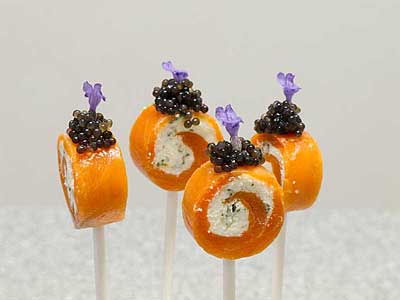August 15, 2011
Amuse-Bouche

« lollipops » de saumon fumé
(smoke-salmon “lollipops”)
The OED shows usage of the word lollipop back to the 1780s with a definition of something sweet on a stick. Since in modern times the wooden stick has been replaced by a paper one, I think the definition can be expanded to mean any edible item on a stick. I think it’s perfectly fine if we mound some fish and cheese on a paper stick and refer to it as a lollipop.
The idea for this particular lollipop is not original. In 2009, I staged at the Michelin one-star restaurant La Folie in San Francisco. Each night there was two amuse-bouches given to each diner. One was a warm egg yolk in a thick soup served in the egg shell where only the flavor of soup changed from day to day; the other amuse-bouche changed every few days, and it was usually meat-centric. If you were identified by the wait staff as a VIP, you received a third amuse-bouche in addition to the first two, a smoked-salmon lollipop. As a stagiaire, I plated all three amuse-bouches as they were ordered. The cook who was in charge of all the cold dishes would secretly make the lollypops in batches and dole out a few for each service, providing an air of mystery to its preparation.
One day the following summer, I was blessed with a wad of leftover smoked salmon and cream cheese from a cooking class, and I decided to recreate the lollipops. The two major components are cold-smoked salmon (lox) and some type of a malleable, fresh cheese. Just about any fresh cheese with work, whether from a goat or cow, as long as it can be formed into a semi-soft, cohesive block. I used the surplus Philadelphia-style cream cheese and thinned it slightly with heavy cream to make it more spreadable. I flavored it with finely minced, fresh thyme and a little fine salt.
The assembly process is the same as making sausage using plastic wrap as a casing. Lay a 30-cm (12-in) long piece of plastic wrap flat on your cutting board, or as I do, directly on your countertop. Arrange a rectangle of smoked salmon in a mostly single layer on the plastic. Press any overlapping areas so the surface of the salmon is level. The rectangle should be parallel to the edge of the plastic wrap nearest you and spaced about 5 cm (2 in) in from the edge. The length of the rectangle running parallel to the edge should be about 10 to 15 cm (4 to 6 in). The height of the rectangle should be, maybe, about 10 cm (4 in). It’s hard to be certain because so much depends on how full the final package will become. In the end, you’d like the salmon to spiral out from the center and to fully wrap the cheese so none is exposed. Once you’ve arranged the salmon, spread a thin layer of cheese over the lower two-thirds of the rectangle with the uncovered area along the edge towards the rear. (And by thin, I mean very, very thin.)
To turn the flat arrangement into a cylinder, pick up the edge of the plastic wrap nearest you and using it to manipulate the salmon and cheese, roll the salmon into a tight spiral. Use a plastic bench scraper to push in at the crease, where the leading edge of plastic wrap is now against the trailing plastic wrap, to tighten it without pressing directly against the salmon cylinder. Once tight, completely roll the cylinder in the plastic wrap and twist the loose ends to force the cylinder tight and round. If the twisted ends want to untwist, tie them tightly with string. Place the cylinder in your freezer until solid. Once frozen, the cylinder can be unwrapped, rewrapped with a smaller piece of plastic wrap, and returned to the freezer.
Since a single cylinder is enough for two or three small parties, I’ll partially thaw and refreeze it a number of times until it’s gone. Each time, I add a new tight layer of plastic wrap to seal the cut end of the cylinder.
To use the salmon cylinder, transfer the frozen cylinder to your refrigerator for an hour or so. Then, mark a series of dots right on the plastic wrap with a Sharpie, spaced 8 mm (1⁄3 in) apart, one dot for each lollipop. Next, using a fat, sharp-pointed skewer, poke a hole into each dot to a depth of about two-thirds of the cylinder diameter. Insert a paper lollipop stick into each hole. Then, using a very sharp knife and a slicing motion, cut halfway between each stick and through the plastic wrap to separate the individual lollipops. Place the lollipops flat on a plate and set the plate back into your refrigerator until its time to serve them. Cover the cut end of the remaining cylinder with plastic wrap and return it to its place in the freezer.
When it comes time to serve the lollipops, carefully remove the plastic wrap from each one and place the sticks into what ever you’ll use for serving. I use a shot glass filled with rock salt to support each lollipop. At La Folie, the lollipops are garnished with a dab of caviar and a leaf or two from some miscellaneous micro-green. For the picture above, I used pike caviar and a lavender bud.
© 2011 Peter Hertzmann. All rights reserved.
